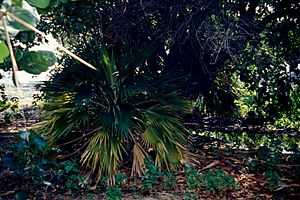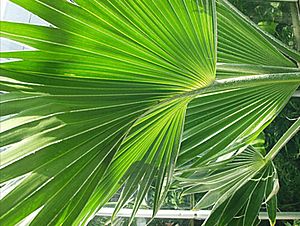Hawai'i pritchardia facts for kids
Quick facts for kids Hawai'i pritchardia |
|
|---|---|
 |
|
| Conservation status | |
| Scientific classification | |
| Genus: |
Pritchardia
|
| Species: |
affinis
|
The Pritchardia affinis, also known as the Hawai'i pritchardia, is a special type of palm tree. It is found only in the Hawaiian Islands. This means it is endemic to Hawaii, which means it naturally grows nowhere else in the world. You can find wild groups of these palms on the drier, or "leeward," side of the Island of Hawaiʻi.
Long ago, Native Hawaiians likely grew these trees. Because of this, we are not completely sure where they originally grew in the wild. These tall palms can grow to be about 10 to 25 meters (about 33 to 82 feet) high.
Contents
What is the Hawai'i Pritchardia?
The Hawai'i pritchardia is a beautiful and important part of Hawaii's nature. It is known for its tall, straight trunk and large, fan-shaped leaves. These leaves form a crown at the top of the tree. The tree also produces small, round fruits.
Where Does It Live?
This palm tree prefers areas that are not too wet. It grows on the leeward side of the Island of Hawaiʻi. This side of the island gets less rain. It is often found in dry forests and on rocky slopes. The tree is very good at living in these specific conditions.
Why is This Palm in Danger?
Sadly, the Hawai'i pritchardia is an endangered species. This means it is at a very high risk of disappearing forever. The United States government has officially listed it as an endangered species.
Main Threats to the Tree
There are a few big reasons why this palm is in trouble:
- Rats: Rats are a major problem. They climb the trees and eat the seeds before they can sprout and grow into new trees. This stops the palm from making new plants.
- Pigs: Wild pigs also cause damage. They can dig up young plants and disturb the soil around the trees. They might also eat seeds or damage the roots.
These animals make it very hard for new Hawai'i pritchardia trees to grow. This is why the tree's population is shrinking.
Its Special Connection to Birds
The fruit of the Hawai'i pritchardia was once the favorite food of a bird called the ula-ai-hawane. This bird was also unique to Hawaii. Unfortunately, the ula-ai-hawane is now extinct, meaning it no longer exists.
Today, another bird seems to have taken its place. This bird is called the lavender waxbill. It is not native to Hawaii, but it now eats the fruit of the Hawai'i pritchardia. This shows how nature can adapt, even when one species disappears.



